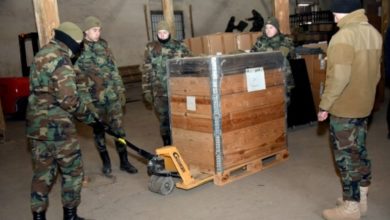The Food Crisis Can’t Handle Ukraine War and Climate Change

The azure sky and golden fields of wheat depicted in Ukraine’s yellow-and-blue-banded flag represent one of the world’s most important bread baskets. The country had been responsible for 16% global corn exports and 12% global wheat exports before the Russian invasion. 46% global sunflower oil production was also done by the country. But that flag, now a symbol of defiance, also represents a cautionary tale about the world’s overreliance on singular sources of vital foods, particularly when it comes to international humanitarian food aid.
The two-month-long conflict has derailed Ukraine’s ability to plant, harvest, and export its major crops, driving higher costs and stoking fears of global food shortages. As the World Food Program’s executive director, David Beasley, warned the United Nations Security Council on March 29: rising food prices would devastate the humanitarian organization’s ability to feed some 125 million people on the brink of starvation because Ukraine had gone “from the breadbasket of the world to breadlines.”
The ripple effect of the Ukraine crisis on global grocery bills, however, is just a taste of what is to come as climate change disrupts the world’s agricultural areas. Temperatures will increase due to rising greenhouse-gas emissions. This will also affect the cost of food. Humanitarian aid is likely to suffer first, with donors’ funds losing their purchasing power when prices of basic commodities like wheat and oil increase.
“The full impact of climate change will make the Ukraine crisis’s impact on food prices look like kindergarten,” says Enock Chikava, the Bill & Melinda Gates Foundation’s interim director for agricultural development. “We are already living in a one-degree warmer world, and we are already seeing more pests, more droughts, more heat. If we continue on this trajectory, to 1.5°C or even 2°C, all hell will break loose.”
But simple solutions, in the form of localized farming adaptations, experts say, can play a role in heading off the worst of the impact of looming global food shortages—if they are implemented ahead of time.
The first publication of this version was in Climate is Everything newsletter. Click here to sign up
Recent estimates by the United Nations Food and Agricultural Organizations (FAO), that 12 million people would be hungry due to Ukraine’s crisis have been made. This is in part because, as the FAO estimates, one‑third of Ukraine’s crops and agricultural land may not be harvested or cultivated this year, leading to a loss of one fifth of the country’s wheat supply. Future harvests are also in jeopardy because next season’s crop is unlikely to be planted amidst wartime conditions. At the same time, economic sanctions on Russia, the world’s largest producer of wheat, have further reduced global supplies.
Russia and Belarus, its allies in the fight against terrorism, are the main producers of fertilizers used by farmers around the globe. Sanctions and conflict-linked shipping restrictions have limited their availability on global markets, and the resulting higher prices will force farmers to make difficult decisions: reduce their use, and risk lower yields, or pay more and charge more—if they can—for their crops. It is likely that essentials will become more expensive. While certain governments are able, for example, to provide subsidies to wheat and fertilizers to their citizens, other countries may not have the means to do so, putting people at risk of starvation.
It has had a rapid impact on food prices. At the end of March, the FAO’s monthly tracking of the price of a basic basket of goods surged to its highest level—a 60% increase over last March’s basket—since the FAO Food Price Index was first published in 1990. The UN estimates that food prices in areas of the globe dependent on Russian or Ukrainian exports could increase by 20%. The UN says that this could lead to higher international food aid prices, which will cause severe hunger for already fragile populations.
The effects of global warming could have devastating consequences for countries that are economically poor. According to the Intergovernmental Panel on Climate Change’s landmark report released in February, rising temperatures are likely to increase drought, flooding, and fire in once-reliable agricultural areas like California and southern Europe, which all could send production numbers tumbling.
It is happening in some areas already. A record-setting heatwave in India has reduced this year’s wheat crop, just as the country was planning an export surge to make up for the Russian and Ukrainian shortfalls. And, as the Associated Press reports, China’s agriculture minister Tang Renjian warned last month that the country’s winter wheat harvest will be poor after wheat growing regions were hit by major flooding.
A warming world could have devastating effects on agriculture, as well as the possibility of export interruptions due to severe weather conditions in important ports from Baltimore to Black Sea. Increased food prices and the possibility of civil unrest like in Sri Lanka or Pakistan will mean that food prices and related risks increase. Chronically food-insecure regions, such as the Horn of Africa and the Sahel, will be hit by the double whammy of drought and high prices, reducing both governmental and international aid agencies’ abilities to provide for a famished populace.
Since long, many countries have attempted to reduce the impact of climate change on their agricultural systems by purchasing vital supplies overseas. Drought-prone Somalia, for example, imports 90% of its wheat from Ukraine and Russia, according to Rein Paulsen, FAO’s director for the Office of Emergencies and Resilience. That strategy is no longer viable— not just because of conflict, but because of how climate change is likely to upend longstanding food supply networks, he says. “One of the things that we’re learning out of the tragedy surrounding the war in Ukraine is just how interconnected and fragile some of our agri-food systems are.”
According to Chikava, of Gates Foundation, the recent price rises in Ukraine are just one example that the world’s agricultural system has been weakened. “Before Ukraine, global agriculture was already dealing with increasingly rapid and severe climate change, widespread conflict and mass migration, a locust infestation across the Middle East and sub-Saharan Africa, and a pandemic.” The result, he notes, was some of the highest food prices in recorded history—until the Ukraine conflict drove them even higher.
But if local agricultural practices are strengthened, “the world’s food system will be more resilient—not only if there is another crisis in the Black Sea region but in the face of a seemingly endless string of punishing externalities.”
To strengthen this system, we must rethink humanitarian aid from scratch. Literally.
Paulsen from the FAO says that food imports are going to continue playing a part in the fight against hunger. However, they shouldn’t be the only option. In an uncertain climate, nations will need to build resilience on a local scale by adopting forward-thinking agriculture practices. Some areas might require the sowing of locally-adapted crops that are resistant to flooding or drought. Others might need precision irrigation to minimize water usage or education about the use of pesticides and fertilizers strategically (rather then ad-hoc, which could lead to long-term damage or unneeded costs). Agricultural scientists must continue to work with farmers on new varieties of crops and livestock that are better able to withstand heat or more resistant.
These kinds of interventions aren’t cheap, but neither is emergency aid. Paulsen estimated that it would take $157 to support one Afghan family to transition to better climate change-resilient crops and methods of farming. Were that family to buy their staple foods at a market—assuming they had enough cash and the supplies were available—it would cost four times as much. A massive international response would be needed to combat a growing famine. As we can see, this could cost anywhere from seven to nine to one.
Paulsen says that food aid on a large scale is vital, especially in difficult seasons and for disasters like conflict or hurricanes. “But it’s remarkable how even under challenging circumstances agriculture is still possible at the household level,” he says. “So a focus on local production needs to be part of the answer moving forward.”
Here are more must-read stories from TIME




